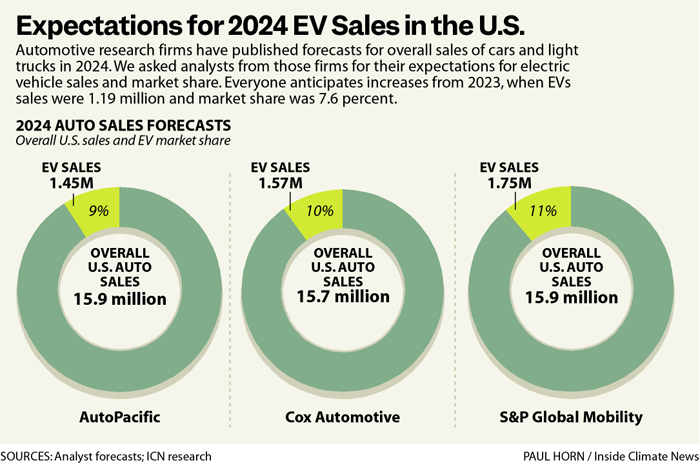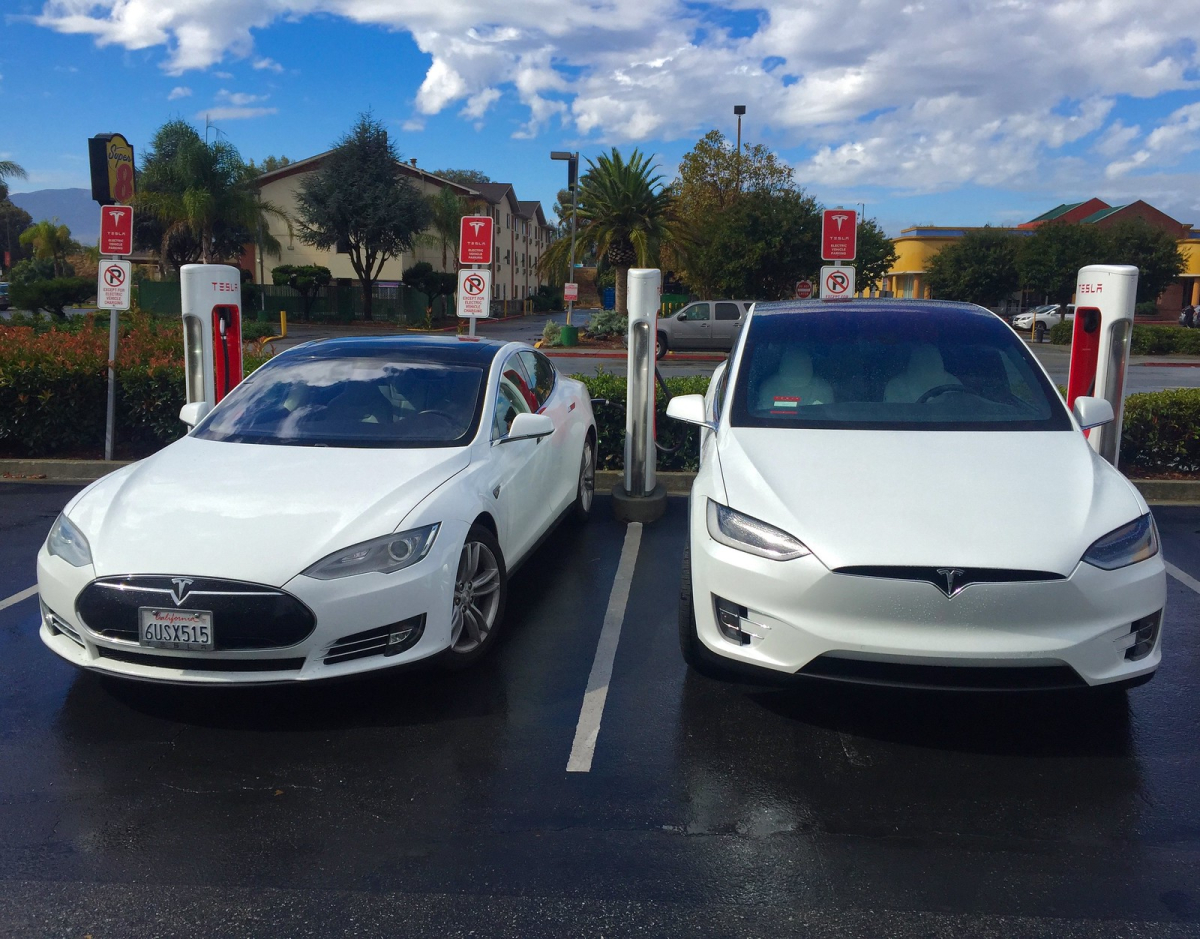Support strong Canadian climate journalism for 2025
This story was originally published by Inside Climate News and appears here as part of the Climate Desk collaboration.
Talk of an implosion of the U.S. electric vehicle market is verging on ridiculous.
While there are some serious challenges surrounding EVs — such as the need to build out the nation’s charging infrastructure — automakers are on track to continue on a path of substantial growth.
Leading forecasters agree that sales and market share will continue to grow in 2024. But they disagree on the rate of growth, and give different weights to some of the main factors that affect the market, from gasoline prices to the availability of low-cost models.
First, some context:
Pessimism about the EV market gained momentum last year when Ford and General Motors said demand for the vehicles was falling short of expectations and pared back aspects of their EV plans. At the same time, Tesla warned investors of “enormous challenges” related to the production and rollout of the Cybertruck. Some auto dealers raised concerns about difficulty selling EVs, including a coalition of more than 4,700 dealers who wrote to U.S. President Joe Biden asking him to slow down on rules that encourage the shift away from gasoline.
These problems get amplified by commentary, often from partisan sources, that seem eager to hold a funeral for the energy transition. A recent opinion piece in The Hill has this headline: “As demand for EVs plummets, Biden’s green fantasy is pummelling U.S. auto dealers.” The author, Mandy Gunasekara, was chief of staff at the Environmental Protection Agency during the Trump administration and is now a visiting fellow at the Heritage Foundation, a conservative think tank.
Despite the storm clouds, sales were strong in 2023. U.S. consumers bought 1.19 million all-electric vehicles last year, up 46 per cent from the prior year, according to Cox Automotive. EVs had a 7.6 per cent share of overall car and light truck sales, up from 5.9 per cent in the prior year.
It was the first time U.S. EV sales reached one million in a year.

So what does 2024 look like?
I gathered 2024 U.S. automotive forecasts from AutoPacific, Cox and S&P Global Mobility. Their projections show increases in EV sales ranging from about 20 per cent from AutoPacific, to more than 30 per cent from the others, compared to the prior year.
“EV sales are increasing faster than any other segment in the industry,” said Michelle Krebs, executive auto analyst for Cox.

A major impediment is that the market doesn’t have enough EVs that cost $35,000 or less, said Ed Kim, president and chief analyst at AutoPacific.
“We have too many EVs now that are at luxury price points,” he said, referring to the many models that are priced at $50,000 and above.
This is one of the major reasons his firm is expecting growth to slow compared to 2023.
Several more affordable models are set for release in 2024, such as the Chevrolet Equinox EV and Volvo EX30. But it will still be a few years before just about every automaker has one or more affordable options.
Kim predicts 2026 will be a likely inflection point for low-cost EVs. Some of the models that may be available then: a Tesla that will sell for $25,000 and a new version of the Chevrolet Bolt from General Motors.
Michael Brisson, an economist for Moody’s Analytics, said gasoline prices are a key variable. If prices spike, it helps EV sales.
The major theme he sees is that automakers know EV demand will grow, but don’t have a firm grasp on the rate of growth or the timing.
“Supply and demand are continuing to try to find each other,” he said.
The analysts all pointed to the lack of charging infrastructure as a major factor holding some people back from buying an EV. Tesla is the only major maker of EVs that has succeeded in building a large charging network. (Most auto brands are adopting a common plug standard that will allow them to use some Tesla Supercharger locations, but it’s not yet clear how this will work in practice.)
The 2021 federal infrastructure law was supposed to lead to a surge in the deployment of public charging stations. But the process of approving projects and getting them built has been slow, as I wrote in December when I visited the first station funded by the law.
Automakers and government programs can vastly expand the number of stations, and they know it and are working on it.
The shift to electric vehicles is far from a smooth ride, but the numbers — both 2023 sales and 2024 forecasts — do not support the idea that we are in some kind of apocalyptic event for this segment of the auto market. The forecasters expect EV market share to reach nine per cent to 11 per cent this year, which would be a substantial increase from the prior year.
If market share grows at that pace despite the many challenges, this bodes well for the middle and latter part of this decade, when there will be many more models available and charging infrastructure should be much more robust.
In the meantime, we need to avoid reading too much into individual data points. For example, anyone pointing to Ford’s 11 per cent drop in EV sales in January, compared to the same month last year, is grasping at straws if they are trying to make a larger point about EV demand.
January is part of the slow season for auto sales, and it is prone to weather factors that make it especially unhelpful for drawing larger conclusions.
“January is not any month that you should judge anything for,” Krebs said.






Comments
The anti-EV crowd will grasp at any straw they can get, right or wrong. These neanderthals have been too busy listening to social media nonsense and conspiracy theories. None of them seem to have enough brain cells to fact check or investigate the truth. In my area, a couple of these folks who own large pickup trucks seem to go out of their way to ensure their vehicles belch black smoke when divining through the downtown core. Apparently, there is some additive they put in their tanks for that purpose. It just shows the lack of intelligence these people have and brainwashed by disinformation by the conservative right.
But I also found that GM or Ford have not targeted EV to the average consumer, instead Ford targeted the F150 and Mustang, not something the average Canadian family would buy. I always wonder why Ford only offers a hybrid Escape than a full EV. I would trade in my fossil fuel Escape for a full Escape EV, so until they do, I will hold off (not the 1st year model of course). But I see GM is now offering a full EV Blazor, so we will see how that works out in the first year.
But the auto industry also needs to ensure the battery arrays are fully serviceable (cell & module level), rather than what they are doing now. If one cell dies and it ends up a major expense. This is something the government needs to mandate for all EVs sold in Canada.